 The Erechtheion
The Erechtheion
The Ionic style is thinner and more elegant. It was found in eastern Greece and was fully developed in the 6th century BC. Most often it was used in the cities of Ionia (now the west coast of Turkey) and some of the Aegean islands. Its capital is decorated with the distinctive feature of the order, a scroll-like design (a volute).
 The Erechtheum is one of the masterpieces of Greek architecture constructed between c.421 BC and 405 BC. It contained sanctuaries to Athena Polias, Poseidon, and Erechtheus. The temple displays the finest examples of the Greek Ionic order. The requirements of the several shrines and the location upon a sloping site produced an unusual plan.
The Erechtheum is one of the masterpieces of Greek architecture constructed between c.421 BC and 405 BC. It contained sanctuaries to Athena Polias, Poseidon, and Erechtheus. The temple displays the finest examples of the Greek Ionic order. The requirements of the several shrines and the location upon a sloping site produced an unusual plan.
The  temple faces east and its entrance is lined with six long Ionic columns that support the northwest – corner porch. Another porch, the one at the south-west corner is supported by six massive female statues, the famous Caryatids.
temple faces east and its entrance is lined with six long Ionic columns that support the northwest – corner porch. Another porch, the one at the south-west corner is supported by six massive female statues, the famous Caryatids.
 The Caryatids have become the temple’s signature feature, as they stand and seem to casually support the weight of the porch’s roof on their heads. All the Caryatids on site today are exact replicas, while the originals are protected by the corrosive air of modern Athens in the Acropolis museum. One of the six Caryatids can be seen in the London museum having been appropriated by Lord Elgin along with the Parthenon marbles.
The Caryatids have become the temple’s signature feature, as they stand and seem to casually support the weight of the porch’s roof on their heads. All the Caryatids on site today are exact replicas, while the originals are protected by the corrosive air of modern Athens in the Acropolis museum. One of the six Caryatids can be seen in the London museum having been appropriated by Lord Elgin along with the Parthenon marbles.
The exterior of the temple was decorated with a continuous frieze. The theme of the frieze is not known, but its form was unusual because white marble figures carved in relief were attached to a flat background of dark gray marble. Traditionally, a frieze used to present vividly painted figures on a monochrome painted background.

 The Erechtheion
The Erechtheion The Erechtheum is one of the masterpieces of Greek architecture constructed between c.421 BC and 405 BC. It contained sanctuaries to Athena Polias, Poseidon, and Erechtheus. The temple displays the finest examples of the Greek Ionic order. The requirements of the several shrines and the location upon a sloping site produced an unusual plan.
The Erechtheum is one of the masterpieces of Greek architecture constructed between c.421 BC and 405 BC. It contained sanctuaries to Athena Polias, Poseidon, and Erechtheus. The temple displays the finest examples of the Greek Ionic order. The requirements of the several shrines and the location upon a sloping site produced an unusual plan. temple faces east and its entrance is lined with six long Ionic columns that support the northwest – corner porch. Another porch, the one at the south-west corner is supported by six massive female statues, the famous Caryatids.
temple faces east and its entrance is lined with six long Ionic columns that support the northwest – corner porch. Another porch, the one at the south-west corner is supported by six massive female statues, the famous Caryatids. The Caryatids have become the temple’s signature feature, as they stand and seem to casually support the weight of the porch’s roof on their heads. All the Caryatids on site today are exact replicas, while the originals are protected by the corrosive air of modern Athens in the Acropolis museum. One of the six Caryatids can be seen in the London museum having been appropriated by Lord Elgin along with the Parthenon marbles.
The Caryatids have become the temple’s signature feature, as they stand and seem to casually support the weight of the porch’s roof on their heads. All the Caryatids on site today are exact replicas, while the originals are protected by the corrosive air of modern Athens in the Acropolis museum. One of the six Caryatids can be seen in the London museum having been appropriated by Lord Elgin along with the Parthenon marbles.


